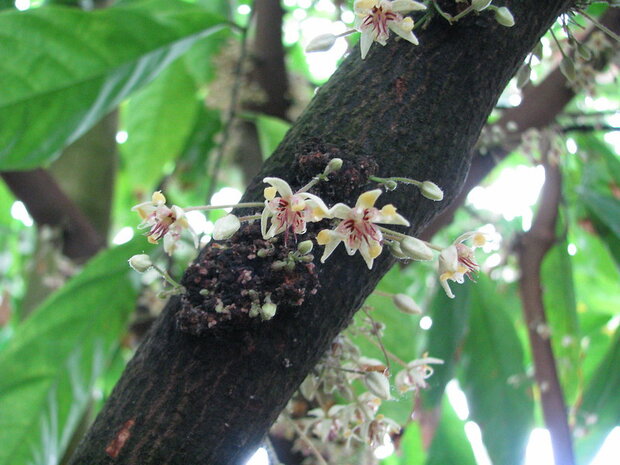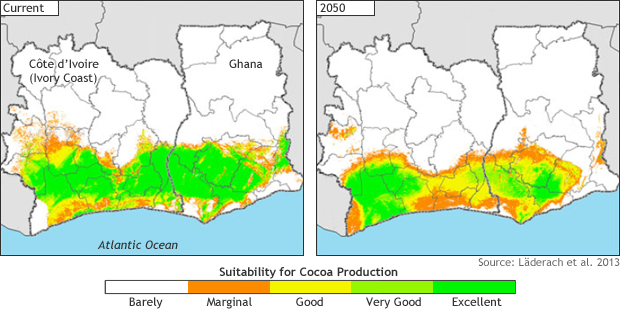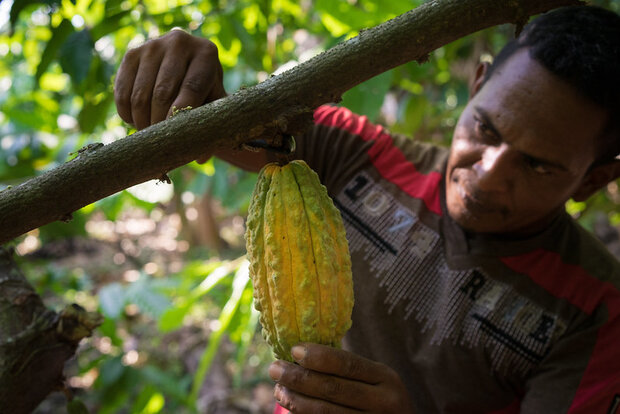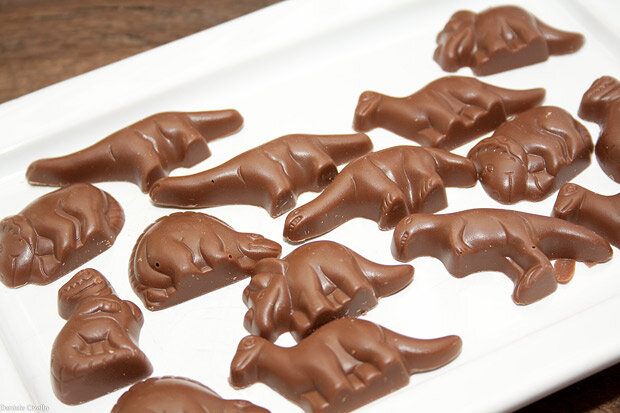Climate & Chocolate
Carob is a brown powder made from the pulverized fruit of a Mediterranean evergreen. Some consider carob an adequate substitute for chocolate…because it can, when combined with vegetable fat and sugar, be made to approximate the color and consistency of chocolate. Of course, the same arguments can as persuasively be made in favor of dirt.
—Sandra Boynton
CHOCOLATE: The Consuming Passion
Strawberries dipped in chocolate. Photo by Flickr user kristina.
For chocolate lovers, there is simply no substitute, and if cocoa beans could be cultivated anywhere, cocoa (Theobroma cacao) trees might outnumber apple trees in American yards. They would certainly outnumber any plants that produced vegetables.
Unfortunately, cacao trees don't thrive in the temperate climate of the continental United States. Chocolate grows best in the places where it would quickly melt in your hands. Over the next several decades, those places may grow warmer, drier, and less suitable to cacao cultivation. But with planning and adaptation, cacao farmers can keep producing our favorite treat.
The geography of chocolate
Cacao can only grow within about 20° north and south of the equator—south of the Mediterranean home of carob, in fact. Cacao trees only prosper under specific conditions, including fairly uniform temperatures, high humidity, abundant rain, nitrogen-rich soil, and protection from wind. In short, cacao trees thrive in rainforests.
Chocolate is now grown around the globe—typically within 10° north and south of the equator. The world's leading producers are Côte d’Ivoire, Ghana, and Indonesia. Côte d'Ivoire and Ghana produce over half of the world's chocolate. But research highlighted in the Intergovernmental Panel on Climate Change (IPCC) Climate Change 2014: Impacts, Adaptation, and Vulnerability report indicates that, under a “business as usual” scenario, those countries will experience a 3.8°F (2.1°C) increase in temperature by 2050, and a marked reduction in suitable cultivation area.
It’s not the heat, it’s the (lack of) humidity
Another staple of American consumption, coffee, suffers direct harm from rising temperatures, but chocolate is different. Rising temperatures alone won’t necessarily hurt cacao production. Cacao cultivation areas in Malaysia, for instance, already endure a warmer climate than in West Africa without any obvious negative effect.
Cacao blossoms in the New York Botanical Garden, Bronx. Photo by Flickr user Kerry Woods.
The danger to chocolate comes from an increase in evapotranspiration, especially since the higher temperatures projected for West Africa by 2050 are unlikely to be accompanied by an increase in rainfall, according to business-as-usual carbon dioxide emissions scenarios. In other words, as higher temperatures squeeze more water out of soil and plants, it's unlikely that rainfall will increase enough to offset the moisture loss.
Some of the research highlighted by the IPCC 2014 report is a 2013 study headed by Peter Läderach. Läderach authored a 2011 paper giving a pretty dire forecast for cacao cultivation; the 2013 study reaches slightly less worrisome conclusions, though challenges to West Africa cacao growers remain.
An uphill battle
By 2050, rising temperatures will push the suitable cacao cultivation areas uphill. The IPCC reported that Côte d'Ivoire and Ghana’s optimal altitude for cacao cultivation is expected to rise from 350–800 feet (100–250 meters) to 1,500–1,600 feet (450–500 meters) above sea level.
These maps show suitability for cacao cultivation at present (left) and projected for 2050 (right). Image adapted from Läderach et al. 2013.
Läderach and his team report that areas expected to show improved cultivation conditions are often hilly terrain. One example is Ghana’s Atewa Range. It’s a forest preserve where cultivation isn’t permitted. Cacao-growing countries may have to choose which priority matters more: growing a product to meet a global demand, or preserving natural habitat.
In fact, Läderach and coauthors found that, of the 294 locations examined in the study, only 10.5% showed increasing suitability for cacao production; the remaining 89.5% were likely to become less suitable by 2050. The authors continued, “These changes in climatic suitability are predicted to take place over a time period of almost 40 years, so they will mostly impact the next rather than the current generation of cocoa trees and farmers. In other words, there is time for adaptation.”
Helping chocolate cope with climate change
One adaptation strategy could be providing cacao growers with selectively bred seeds that have superior drought resistance. Another strategy involves a traditional cacao cultivation method that takes advantage of the conditions under which cacao naturally grows.
Cacao harvesting in Colombia. Photo by the U.S. Agency for International Development (USAID).
Known in Brazil as cabruca, this approach involves retaining, or in some cases replanting, other rainforest trees, which provide cacao trees with shade. (Like Northern European tourists in the Mediterranean, cacao trees benefit enormously from shade.) This approach could help decrease both temperature and evapotranspiration.
The taller trees also provide protection from wind and soil erosion, and nutrient-rich leaf litter. Cacao trees cultivated in this approach appear less vulnerable to pests, and the soil better retains its ability to support cacao over the long term.
Cabruca offers one more advantage: Carbon that would otherwise be released into the atmosphere when forests are cleared isn't. It remains stored in the trees. A study conducted in southern Cameroon and published in 2009 found that cacao forests in that region store on average 243 metric tons per hectare (about 2.5 acres). (For comparison, in 2011–2015, the World Bank reported, U.S. citizens released about 17.0 metric tons of carbon dioxide per person per year.) Another study, conducted in Brazil and published in 2014, concluded that judicious cabruca practices could double cacao production in a climate-friendly manner.
Chocolate promotes science literacy among children by forming dinosaurs. Photo by Flickr user Daniele Civello.
So while you may not be able to grow your own chocolate in your own back yard, you can still enjoy this most delectable of treats, delivered from exotic lands. If cacao growers are able to plan for the future, that will be good news for your taste buds and our planet.
References
Coe, S.D., Coe, M.D. (2000). The True History of Chocolate. Thames and Hudson.
Dasgupta, P., J.F. Morton, D. Dodman, B. Karapinar, F. Meza, M.G. Rivera-Ferre, A. Toure Sarr, and K.E. Vincent. (2014). Rural areas. In: Climate Change 2014: Impacts, Adaptation, and Vulnerability. Part A: Global and Sectoral Aspects. Contribution of Working Group II to the Fifth Assessment Report of the Intergovernmental Panel on Climate Change [Field, C.B., V.R. Barros, D.J. Dokken, K.J. Mach, M.D. Mastrandrea, T.E. Bilir, M. Chatterjee, K.L. Ebi, Y.O. Estrada, R.C. Genova, B. Girma, E.S. Kissel, A.N. Levy, S. MacCracken, P.R. Mastrandrea, and L.L. White (eds.)]. Cambridge University Press, Cambridge, United Kingdom and New York, NY, USA, pp. 613-657.
Daymond, A.J., Hadley, P. (2004). The effects of temperature and light integral on early vegetative growth and chlorophyll fluorescence of four contrasting genotypes of cacao (Theobroma cacao). Annals of Applied Biology, 145(3), 257–262.
Daymond, A.J., Hadley, P. (2008). Differential effects of temperature on fruit development and bean quality of contrasting genotypes of cacao (Theobroma cacao). Annals of Applied Biology, 153(2), 175–185.
Johns, N.D. (1999). Conservation in Brazil's chocolate forest: The unlikely persistence of the traditional cocoa agroecosystem. Environmental Management. 23(1), 31-47.
Läderach, P., Martinez-Valle, A., Schroth, G., Castro, N. (2013). Predicting the future climatic suitability for cocoa farming of the world’s leading producer countries, Ghana and Côte d’Ivoire. Climatic Change, 119, 841–854.
Rice, R.A., Greenberg, R. (2000). Cacao cultivation and the conservation of biological diversity. AMBIO: A Journal of the Human Environment, 29(3), 167-173.
Schroth, G., Jeusset, A., Gomes, A. da S., Tavares, Florence, C.T., Coelho, N.A.P., Faria, D., Läderach, P. (2014). Climate friendliness of cocoa agroforests is compatible with productivity increase. Mitigation and Adaptation Strategies for Global Change, 21(1), 67–80.
Silberner, J. (2007, November 19). How chocolate can save the planet. National Public Radio. Accessed July 27, 2011.
Sonwa, D.J., Weise, S.F., Nkongmeneck, B.A., Tchatat, M., Janssens, M.J.J. (2009). Carbon stock in smallholder chocolate forest in southern Cameroon and potential role in climate change mitigation. IOP Conference Series: Earth and Environmental Science, 6, 252008.
Traoré, D. (2009, February). Cocoa and Coffee Value Chains in West and Central Africa: Constrains and Options for Revenue-Raising Diversification. United Nations Food and Agriculture Organization. AAACP Paper Series No. 3.
UNdata. (2010, September 15). Carbon dioxide emissions (CO2), metric tons of CO2 per capita (CDIAC). Accessed July 28, 2011.
World Bank. (2016). CO2 emissions (metric tons per capita). Accessed February 1, 2016.




